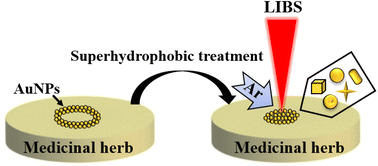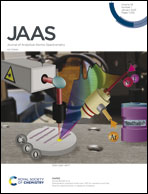High-sensitivity analysis of mercury in medicinal herbs using nanoparticle-enhanced laser-induced breakdown spectroscopy combined with argon purging†
Abstract
Laser-induced breakdown spectroscopy (LIBS) is an atomic spectrum analysis method with the advantage of simple, rapid, and multi-element analysis. It has great application potential for the analysis of heavy metal elements in medicinal herbs. However, when LIBS is used to analyze mercury (Hg) in medicinal herbs, the high recombination rate of mercury plasma and the selective quenching of mercury atomic emission lines by oxygen will reduce the analytical sensitivity. In this work, nanoparticle-enhanced LIBS (NE-LIBS) combined with argon (Ar) purging was used to improve the analytical sensitivity of Hg in the medicinal herb dried tangerine peel. The deposition of nanoparticles (NPs) was optimized by surface superhydrophobic treatment of the sample. The effects of the size, shape, and surface concentration of the NPs on the LIBS signal intensity were analyzed. The flow rate of the Ar jet was optimized. The results showed that detection stability was improved by surface superhydrophobic treatment. The spectral intensity of Hg I 253.65 nm was increased 6.19 times under the optimized parameters of 40 nm diameter nanocages with a surface concentration of 1.77 × 10−3 mg cm−2 and an Ar jet flow rate of 15 L min−1. The calibration curves of Hg I 253.65 nm were constructed under the optimized parameters. According to the calibration curves, the coefficient of determination (R2), root mean square error of cross validation (RMSECV), and limit of detection (LoD) of NE-LIBS combined with Ar purging were 0.9954, 3.47 mg kg−1, and 2.46 mg kg−1, respectively. Compared with traditional LIBS methods, NE-LIBS combined Ar purging improved the analytical sensitivity of Hg in medicinal herbs, with the LoD improved by 9.73 times. The practicability of the method was demonstrated by analyzing dried tangerine peels from other regions and the relative errors were in the range of 0.52–2.70%.



 Please wait while we load your content...
Please wait while we load your content...